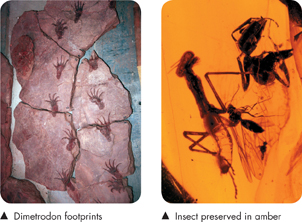19.1 The Fossil Record
 What do fossils reveal about ancient life?
What do fossils reveal about ancient life? How do we date events in Earth's history?
How do we date events in Earth's history? How was the geologic time scale established, and what are its major divisions?
How was the geologic time scale established, and what are its major divisions? How have our planet's environment and living things affected each other to shape the history of life on Earth?
How have our planet's environment and living things affected each other to shape the history of life on Earth?
extinct • paleontologist • relative dating • index fossil • radiometric dating • half-life • geologic time scale • era • period • plate tectonics
Outline Make an outline using the green and blue headings in this lesson. Fill in details as you read to help you organize the information in the lesson.
THINK ABOUT IT Fossils, the preserved remains or traces of ancient life, are priceless treasures. They tell of life-and-death struggles and of mysterious worlds lost in the mists of time. Taken together, the fossils of ancient organisms make up the history of life on Earth called the fossil record. How can fossils help us understand life's history?
Fossils and Ancient Life
 What do fossils reveal about ancient life?
What do fossils reveal about ancient life?
Fossils are the most important source of information about extinct species. An extinct species is one that has died out. Fossils vary enormously in size, type, and degree of preservation, and they form only under certain conditions. For every organism preserved as a fossil, many died without leaving a trace, so the fossil record is not complete.
Types of Fossils Fossils can be as large and perfectly preserved as an entire animal, complete with skin, hair, scales, or feathers. They can also be as tiny as bacteria, developing embryos, or pollen grains. Many fossils are just fragments of an organism—teeth, pieces of a jawbone, or bits of leaf. Sometimes an organism leaves behind trace fossils—casts of footprints, burrows, tracks, or even droppings. Although most fossils are preserved in sedimentary rocks, some are preserved in other ways, like the insect shown in Figure 19–1.

FIGURE 19–1 Diversity of Fossils There are all different types of fossils. A fossil can be a single bone, some footprints, or entire organisms.

Table of Contents
- Formulas and Equations
- Applying Formulas and Equations
- Mean, Median, and Mode
- Estimation
- Using Measurements in Calculations
- Effects of Measurement Errors
- Accuracy
- Precision
- Comparing Accuracy and Precision
- Significant Figures
- Calculating With Significant Figures
- Scientific Notation
- Calculating With Scientific Notation
- Dimensional Analysis
- Applying Dimensional Analysis




